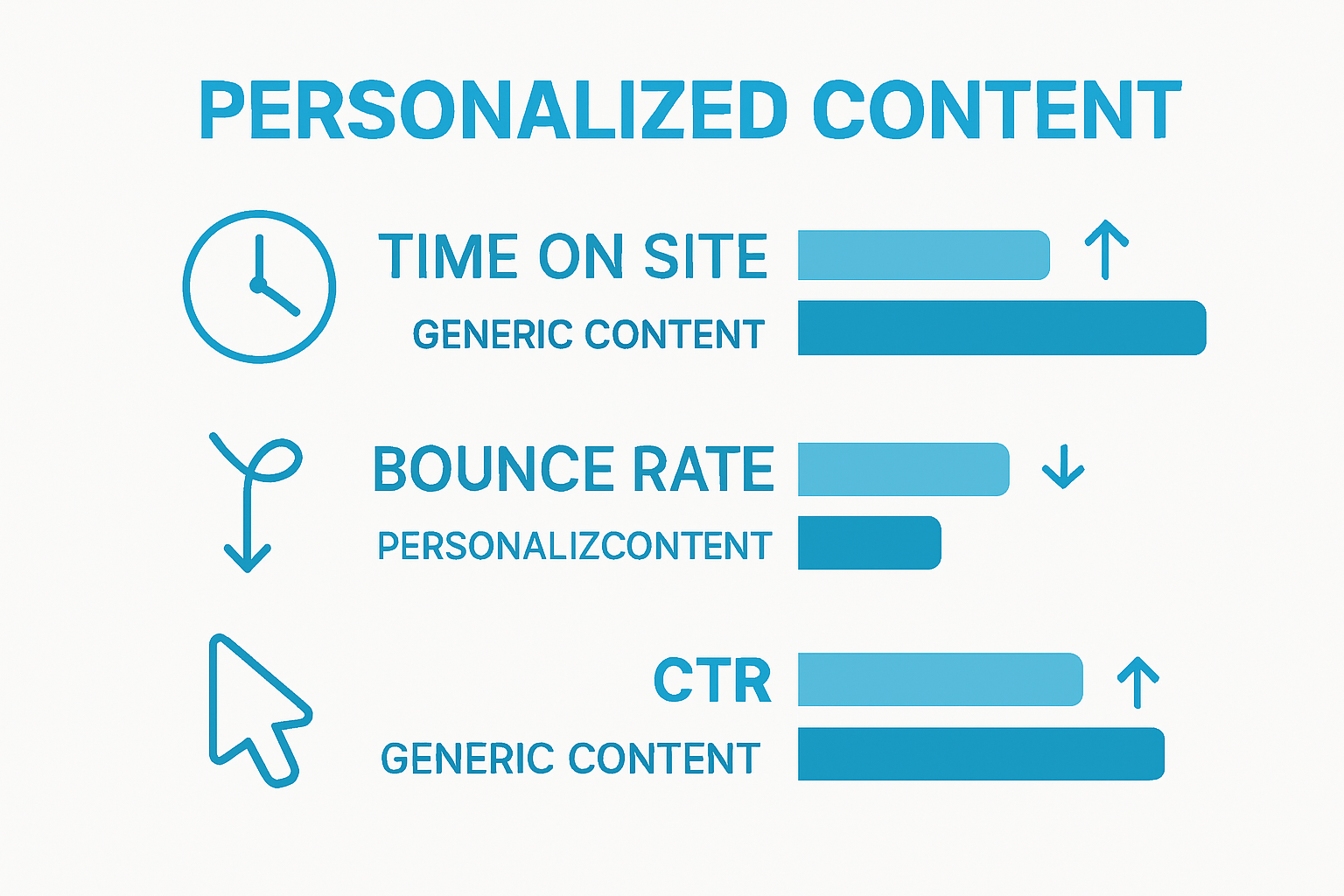Personalization has become the secret weapon for digital marketers who want their message to actually matter. Companies that personalize can increase conversion rates by up to 20 percent, according to recent studies. Sounds impressive but think about this for a second. The real win is not just about more clicks or higher sales. It is about making every visitor feel like your site was designed just for them which changes how people connect and remember your brand.
Table of Contents
- What Is Personalization In Digital Marketing?
- The Role Of SEO In Enhancing Personalization
- Why Personalization Matters For SEO Success
- How Personalization Impacts User Experience And SEO
- Key Concepts Of Integrating Personalization And SEO
Quick Summary
| Takeaway | Explanation |
|---|---|
| Personalization enhances user engagement. | Tailoring content to individual preferences increases user satisfaction and retention on digital platforms. |
| Data collection is essential for personalization. | Gathering detailed user information helps businesses understand and meet specific customer needs effectively. |
| SEO optimizes personalized user experiences. | Effective SEO practices ensure that tailored content aligns with user search intent, boosting visibility and relevance. |
| Dynamic content adaptation is crucial. | Real-time changes to website elements based on user behavior improve engagement and navigation ease. |
| Integration of personalization and SEO is key. | Combining these strategies creates intelligent systems that enhance user satisfaction and search engine rankings. |
What is Personalization in Digital Marketing?
Personalization in digital marketing represents a strategic approach that transforms generic online experiences into tailored interactions specifically designed for individual users. By leveraging data analytics, behavioral insights, and advanced technologies, businesses can create highly targeted communications that resonate with specific audience segments.
Understanding the Core Concept
At its fundamental level, personalization means crafting marketing messages, product recommendations, and user experiences that feel uniquely relevant to each customer. Instead of delivering a one-size-fits-all approach, companies use sophisticated algorithms and data collection methods to understand user preferences, browsing histories, and past interactions.
According to West Virginia University, personalized marketing involves tailoring communications based on individual consumer preferences and behaviors. This approach goes beyond merely inserting a customer’s name into an email – it’s about creating meaningful, contextually relevant experiences.
Key Components of Effective Personalization
Successful digital personalization strategies typically involve several critical components:
- Data Collection: Gathering comprehensive user information through website interactions, purchase history, and demographic details
- Segmentation: Categorizing users into distinct groups with similar characteristics or behaviors
- Dynamic Content: Adapting website elements, product recommendations, and messaging in real-time based on individual user profiles
By implementing personalization and SEO strategies together, businesses can create more engaging digital experiences that not only attract users but also significantly improve conversion rates and customer satisfaction. The goal is to make each user feel understood, valued, and more likely to engage with your brand.
To help clarify the major components of a successful personalization strategy in digital marketing, the following table summarizes their roles and significance.
| Component | Description |
|---|---|
| Data Collection | Collecting comprehensive user data from website usage, purchase history, and demographics to understand preferences and behaviors |
| Segmentation | Grouping users into categories based on similar characteristics or behaviors for more relevant targeting |
| Dynamic Content | Adapting website content, recommendations, and messaging in real-time to match individual user profiles |
The Role of SEO in Enhancing Personalization
Search engine optimization (SEO) plays a critical role in transforming digital personalization strategies by creating more targeted, relevant user experiences. By understanding and implementing advanced SEO techniques, businesses can develop more precise and effective personalization approaches that connect directly with user intent and preferences.
Connecting Search Intent with User Personalization
SEO serves as a bridge between user behavior and content strategy, helping organizations understand what specific audience segments are searching for online. Through comprehensive keyword research and analysis, companies can decode user interests, pain points, and search patterns. This granular understanding allows for more nuanced personalization strategies that align content precisely with user expectations.
According to Digital.gov, SEO best practices are instrumental in improving website structure and content, which enables search engines to provide more contextually relevant search experiences. By optimizing content for specific user queries, businesses can create more personalized digital interactions.
Technical SEO and Personalization Synergy
The technical aspects of SEO directly contribute to enhanced personalization capabilities. Key technical elements that support personalized experiences include:
- User Behavior Tracking: Utilizing analytics to understand how different user segments interact with website content
- Machine Learning Algorithms: Implementing AI-driven systems that adapt content recommendations based on individual user interactions
- Structured Data Markup: Creating clear signals for search engines about content relevance and user intent
Learn more about optimizing user experiences through strategic SEO techniques that make digital interactions more meaningful and targeted. By integrating SEO insights with personalization strategies, businesses can create more intelligent, responsive digital environments that anticipate and meet user needs with unprecedented precision.
Why Personalization Matters for SEO Success
Personalization has transformed from a marketing trend to a critical strategy for achieving meaningful digital engagement and search engine optimization success. By understanding user intent and delivering highly targeted experiences, businesses can significantly improve their online visibility, user satisfaction, and conversion rates.
Impact on User Engagement and Search Rankings
Search engines increasingly prioritize websites that demonstrate high user engagement and relevance. Personalization directly contributes to these metrics by creating more compelling, context-specific content that keeps users on site longer and reduces bounce rates. When users find precisely what they need quickly, search algorithms interpret this as a signal of high-quality, relevant content.
According to research published in the ACM SIGIR Conference, personalizing search results based on user interaction behaviors can significantly enhance information retrieval performance. By analyzing and predicting user preferences, websites can create more targeted experiences that align with individual search intents.
Key Benefits of Personalization for SEO
Businesses implementing personalization strategies can expect several critical advantages:
- Improved User Experience: Tailoring content and recommendations to specific user segments
- Higher Engagement Metrics: Increasing time on site, reducing bounce rates, and improving click-through rates
- Better Conversion Potential: Creating more relevant pathways that guide users toward desired actions
Explore advanced user experience optimization techniques that can transform how your digital platform connects with audiences. By integrating sophisticated personalization approaches, companies can create intelligent digital ecosystems that not only attract users but also anticipate and fulfill their specific needs with unprecedented precision.
How Personalization Impacts User Experience and SEO
Personalization represents a powerful intersection between user experience design and search engine optimization, creating dynamic digital environments that adapt seamlessly to individual user needs and preferences. By understanding how personalization influences both user interaction and search visibility, businesses can develop more intelligent and responsive online strategies.
The User Experience Transformation
Personalization fundamentally changes how users interact with digital platforms by delivering content, recommendations, and interfaces tailored to their specific interests and behaviors. This approach moves beyond generic experiences, creating intuitive pathways that anticipate user needs and reduce friction in navigation and information discovery.
According to research published in ResearchGate, personalized interfaces can significantly enhance user satisfaction by providing more relevant and contextual experiences that align with individual preferences and expectations.
SEO Performance and User Engagement Metrics
Search engines increasingly prioritize websites that demonstrate strong user engagement, making personalization a critical factor in SEO success. Key performance indicators that reflect this connection include:

- Reduced Bounce Rates: Personalized content keeps users engaged longer
- Increased Time on Site: Tailored experiences encourage deeper exploration
- Higher Click-Through Rates: Relevant recommendations drive user interaction
Discover advanced techniques for optimizing user experiences that can transform how your digital platform connects with audiences. By creating intelligent, adaptive environments that respond to individual user needs, businesses can simultaneously improve both user satisfaction and search engine rankings.

Key Concepts of Integrating Personalization and SEO
Integrating personalization and SEO requires a sophisticated approach that combines data analysis, user behavior understanding, and strategic content optimization. By developing a holistic strategy that considers both technical search engine requirements and individual user preferences, businesses can create more intelligent and responsive digital experiences.
Data-Driven Personalization Strategies
Successful integration begins with comprehensive data collection and analysis. This involves gathering detailed insights about user behaviors, preferences, search patterns, and interaction histories. Organizations must develop robust frameworks that can capture nuanced user data while maintaining privacy and adhering to data protection regulations.
According to research exploring real-time personalization, machine learning algorithms play a crucial role in adapting web interfaces and content recommendations based on contextual user interactions and preferences.
Core Integration Principles
Effective personalization and SEO integration relies on several fundamental principles:
- Contextual Relevance: Delivering content that precisely matches user intent and search queries
- Dynamic Content Adaptation: Creating flexible content frameworks that can adjust in real-time
- User Intent Mapping: Understanding and anticipating specific user needs across different interaction stages
Explore advanced SEO and user experience optimization techniques that can transform how digital platforms connect with audiences. By developing intelligent systems that balance technical optimization with personalized experiences, businesses can create more engaging, responsive digital ecosystems that simultaneously satisfy user expectations and search engine algorithms.
The following table compares how personalization and SEO individually contribute to digital marketing and highlights the key benefits when these strategies are combined.
| Strategy | Key Contribution | Resulting Benefit |
|---|---|---|
| Personalization | Tailors content to user preferences | Higher engagement, better retention |
| SEO | Optimizes visibility for search queries | Improved discoverability, increased relevant traffic |
| Integrated Approach | Combines tailored content with search optimization | Enhanced satisfaction, improved rankings and conversions |
Unlock the Power of Personalization and SEO With the Right Tools
Are you struggling to bridge the gap between personalized digital experiences and winning SEO strategies? The article shows how crucial it is to eliminate keyword cannibalization, deliver tailored content, and optimize your site for better engagement. Yet, manual audits and outdated tools hold teams back from real-time impact, which means lost rankings and missed customer connections.
Take action now. Boost your user engagement and improve your search performance by uncovering and fixing hidden keyword cannibalization. Let Rankaligner, the #1 Keyword Cannibalization Tool trusted by SEO consultants and agencies, help you achieve smarter personalization. Visit Rankaligner’s homepage to start identifying your issues and see how our advanced solutions can turn your personalized strategies into measurable success. Your audience is ready for relevant experiences—are you ready to deliver?
Frequently Asked Questions
What is personalization in digital marketing?
Personalization in digital marketing is the strategy of tailoring marketing messages, product recommendations, and user experiences to individual users based on their preferences, behaviors, and past interactions.
How does SEO enhance personalization strategies?
SEO enhances personalization by providing insights into user search intent and behaviors, enabling businesses to create targeted content that aligns with user expectations, ultimately improving relevance and engagement.
Why is personalization important for SEO success?
Personalization is important for SEO success because it increases user engagement metrics, such as reduced bounce rates and improved click-through rates, which search engines interpret as signals of high-quality content.
What are the benefits of integrating personalization and SEO?
Integrating personalization and SEO offers several benefits, including improved user experiences, higher engagement rates, better conversion potential, and the ability to create more intelligence-driven and responsive digital environments.
Recommended
- How SEO and User Experience Work Together for Success – Rank Aligner – Your Ultimate Keyword Cannibalization Problem Solver
- Semantic Search Explained: Boost SEO Results in 2025
- SERP Features Explained: Guide for SEO Success – Rank Aligner – Your Ultimate Keyword Cannibalization Problem Solver
- Top SEO Ranking Factors 2025: A Guide for Consultants

